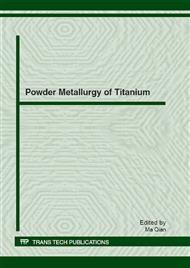p.101
p.111
p.121
p.133
p.139
p.145
p.153
p.161
p.167
Effect of Contaminants on Sintering of Ti and Ti-6Al-4V Alloy Powders in an Argon-Back-Filled Graphite Furnace
Abstract:
This work aims to study sintering of elemental titanium and pre-alloyed Ti-6Al-4V powders in a graphite furnace which is operated with back-filled argon. The specific task is to investigate the effect of carbon, oxygen and nitrogen contamination in the furnace atmosphere during sintering. X-ray diffraction (XRD) reveals that the main phase on the surface of the sintered samples was a titanium oxycarbonitride – Ti(CNO). The surface of all samples was porous due to the reaction between titanium and contaminants. A close-up surface morphological observation with environmental scanning electron microscopy (ESEM) shows the presence of spherical particles in the sintered Ti specimens, but not observed in the Ti-6Al-4V alloy specimens. Energy dispersive spectrometry (EDS) results indicate that these spheres mainly contain carbon and titanium. It is postulated that residual chlorine (Cl), a common impurity for sponge Ti powder but not for pre-alloyed Ti-6Al-4V powder, may play an important role in the formation of these spheres. Microhardness is dependent on the contaminant content on the sample surface. The implication of using graphite furnaces for sintering is discussed.
Info:
Periodical:
Pages:
139-144
Citation:
Online since:
August 2012
Authors:
Keywords:
Price:
Сopyright:
© 2012 Trans Tech Publications Ltd. All Rights Reserved
Share:
Citation:


